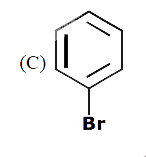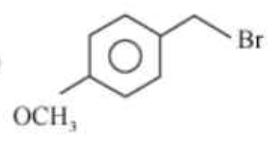Ease of ionization to produce carbocation and bromide ion under the treatment of Ag⊕ will be maximum in ?




The correct Answer is:B
To determine which compound has the maximum ease of ionization to produce a carbocation and bromide ion under the treatment of Ag⊕, we need to analyze the stability of the carbocations formed from the given compounds. The more stable the carbocation, the easier the ionization will be.
1. Identify the Compounds: We need to analyze the stability of carbocations formed from the given options. The question implies that we have several aromatic compounds with bromine substituents.
2. Understanding Carbocation Stability: Carbocations are stabilized by resonance and the presence of electron-donating groups. Aromatic compounds tend to stabilize carbocations due to their resonance structures.
3. Analyze Each Option:
- Option 1: A 5-membered ring with bromine.
- After ionization, a positive charge is formed on a carbon in the ring. This structure is anti-aromatic (4 π electrons), making it unstable. Therefore, ionization is not easy.
- Option 2: A 6-membered ring with an oxygen heteroatom and bromine.
- Upon ionization, a positive charge is formed. The structure can be stabilized by resonance involving the oxygen atom. This compound has 6 π electrons (aromatic), making it stable. Thus, ionization is easier.
- Option 3: Bromobenzene.
- When treated with Ag⊕, the positive charge on the benzene ring makes it unstable. The instability of the carbocation means that ionization is not easy.
- Option 4: A 6-membered ring with a double bond and bromine.
- Similar to option 2, this compound can stabilize the carbocation through resonance. However, the presence of a double bond may affect the stability compared to option 2.
4. Conclusion: Among the options analyzed, Option 2 is the most stable due to its aromatic nature and the ability of the oxygen to stabilize the positive charge through resonance. Therefore, the ease of ionization to produce a carbocation and bromide ion under the treatment of Ag⊕ will be maximum in Option 2.
Final Answer:
The ease of ionization to produce carbocation and bromide ion under the treatment of Ag⊕ will be maximum in Option 2.
- Option 1: A 5-membered ring with bromine.
- After ionization, a positive charge is formed on a carbon in the ring. This structure is anti-aromatic (4 π electrons), making it unstable. Therefore, ionization is not easy.
- Option 2: A 6-membered ring with an oxygen heteroatom and bromine.
- Upon ionization, a positive charge is formed. The structure can be stabilized by resonance involving the oxygen atom. This compound has 6 π electrons (aromatic), making it stable. Thus, ionization is easier.
- Option 3: Bromobenzene.
- When treated with Ag⊕, the positive charge on the benzene ring makes it unstable. The instability of the carbocation means that ionization is not easy.
- Option 4: A 6-membered ring with a double bond and bromine.
- Similar to option 2, this compound can stabilize the carbocation through resonance. However, the presence of a double bond may affect the stability compared to option 2.
The ease of ionization to produce carbocation and bromide ion under the treatment of Ag⊕ will be maximum in Option 2.
Topper's Solved these Questions
- AROMATIC COMPOUNDBOOK - MOTIONCHAPTER - AROMATIC COMPOUNDEXERCISE - Exercise - 2 (Level-I)
47 Videos
- AROMATIC COMPOUNDBOOK - MOTIONCHAPTER - AROMATIC COMPOUNDEXERCISE - Exercise - 2 (Level-II)
29 Videos
- ALKYI HALIDEBOOK - MOTIONCHAPTER - ALKYI HALIDEEXERCISE - Exercise - 4 | Level-II
8 Videos
- ATOMIC STRUCTURE BOOK - MOTIONCHAPTER - ATOMIC STRUCTURE EXERCISE - EXERCISE-4 (LEVEL-II)
18 Videos
Similar Questions
Ease of ionization to produce carbocation and bromide ion under the statement of Ag+ will be maximum in which of the following compounds?




View SolutionIn a hospital the ages of 360 patients for getting medical treatment on a day are as under:

Find the mean of given frequency distribution table
View Solution
Knowledge Check
n-propyl bromide on treatment with ethanolic potassium hydroxide produces
Apropanol-1BpropeneCpropanol-2Dethyl propyl ethern-propyl bromide on treatment with alcoholic potassium hydroxide produces
ApropaneBpropeneCpropyneDpropanoln-propyl bromide on treatment with ethanolic potassium hydroxide produces
APropaneBPropeneCPropyneDPropanol
The equilibrium constant at 278K for Cu(s)+2Ag⊕(aq)⇔Cu2+(aq)+2Ag(s) is 2.0×1015. In a solution in which copper has displaced, some silver ions from the solution, the concentration of Cu2+ ions from the solution, the concentration of Cu2+ ions is 1.8×10−2molL−1 and the concentration of Ag⊕ ions is 3.0×10−9molL−1. Is the system at equilibrium?
View SolutionWrite resonance-contributing structures for the intermedicate carbocation (arenonium ion) of
(i) Phenol
(ii) Nitrobenzene with electrophile CI⊕ at the
a. ortho-,
b. para-, and
c. meta-positions.
View SolutionBromine is commercially produced by the oxidation of bromide ions in natural brine with
View SolutionWhen ethyl bromide is treated with moist Ag2O main product is//are.
View SolutionThe amount of energy required to remove an electron from the last orbit of an isolated (free) atom in gaseous state is known as ionization potential or first ionization potential of the element. Similarly, the energy required for the removal of the electron from the unipositive ion (produced above) is referred to as second ionization potential and thus the third, fourth etc. lonization potentials may be defined in general as the number of ionization potentials of an element may be as much as its number of electrons.
Ionization energy increases on moving down a group due to
View Solution
